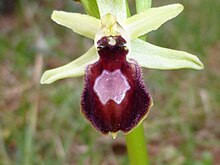Ophrys × arachnitiformis
| False spider orchid | |
|---|---|

| |
| Scientific classification | |
| Kingdom: | Plantae |
| Clade: | Tracheophytes |
| Clade: | Angiosperms |
| Clade: | Monocots |
| Order: | Asparagales |
| Family: | Orchidaceae |
| Subfamily: | Orchidoideae |
| Genus: | Ophrys |
| Species: | O. × arachnitiformis |
| Binomial name | |
| Ophrys × arachnitiformis Gren. & Philippe | |
| Synonyms[1] | |
| |
Ophrys × arachnitiformis, the false spider orchid, is an orchid native to Europe.[2] It is apparently a hybrid resulting from a cross between O. fuciflora × O. sphegodes, but has become established in the wild in Britain, France (including Corsica), Germany, parts of Italy (Liguria, Tuscany, Lazio, Apulia, Sicily, Sardinia), Austria, Switzerland, Hungary, and the former Yugoslavia.[1][3]
Ophrys like other orchids are dependent on symbiotic fungi at some point during their life cycle, but especially for germination, which may take months or even years underground. Orchid roots contain Orchid mycorrhiza, coils of fungal hyphae inside orchid root cells.[4]
References
- ^ a b Kew World Checklist of Selected Plant Families, Ophrys × arachnitiformis
- ^ Grenier, Jean Charles Marie & Philippe, Xavier. 1860. Mémoires, Société d'Émulation du Doubs III, 4: 391
- ^ Altervista Flora Italiana, Ofride a forma di ragno, False Spider Orchid, Ophrys arachnitiformis at altervista.org
- ^ Schweiger, Julienne M.‐I.; Bidartondo, Martin I.; Gebauer, Gerhard (April 2018). Field, Katie (ed.). "Stable isotope signatures of underground seedlings reveal the organic matter gained by adult orchids from mycorrhizal fungi". Functional Ecology. 32 (4): 870–881. doi:10.1111/1365-2435.13042. ISSN 0269-8463.
